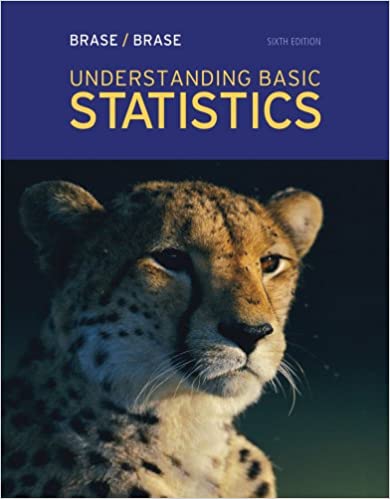
Understanding Basic Statistics 6th Edition by Charles Henry Brase,Corrinne Pellillo Brase
Edition 6ISBN: 978-1111827021
Understanding Basic Statistics 6th Edition by Charles Henry Brase,Corrinne Pellillo Brase
Edition 6ISBN: 978-1111827021 Exercise 33
Expand Your Knowledge: Software Approximation for Degrees of Freedom Given x 1 and x 2 distributions that are normal or approximately normal with unknown 1 and 2 , the value of t corresponding to
 has a distribution that is approximated by a Student's t distribution. We use the convention that the degrees of freedom are approximately the smaller of n 1 1 and n 2 1. However, a more accurate estimate for the appropriate degrees of freedom is given by Satterthwaite's formula:
has a distribution that is approximated by a Student's t distribution. We use the convention that the degrees of freedom are approximately the smaller of n 1 1 and n 2 1. However, a more accurate estimate for the appropriate degrees of freedom is given by Satterthwaite's formula:

where s 1 , s 2 , n 1 , and n 2 are the respective sample standard deviations and sample sizes of independent random samples from the x 1 and x 2 distributions. This is the approximation used by most statistical software. When both n 1 and n 2 are 5 or larger, it is quite accurate. The degrees of freedom computed from this formula are either truncated or not rounded.
(a) In Problem 15, we tested whether the population average crime rate 2 in the Rocky Mountain region is higher than that in New England, 1. The data were n 1 = 10,
 , s 1 0.81, n 2 = 12,
, s 1 0.81, n 2 = 12,
 , and s 2 0.94. Use Satterthwaite's formula to compute the degrees of freedom for the Student's t distribution.
, and s 2 0.94. Use Satterthwaite's formula to compute the degrees of freedom for the Student's t distribution.
(b) When you did Problem 15, you followed the convention that degrees of freedom d.f. = smaller if n 1 1 and n 2 1. Compare this d.f. with that found by Satterthwaite's formula.
 has a distribution that is approximated by a Student's t distribution. We use the convention that the degrees of freedom are approximately the smaller of n 1 1 and n 2 1. However, a more accurate estimate for the appropriate degrees of freedom is given by Satterthwaite's formula:
has a distribution that is approximated by a Student's t distribution. We use the convention that the degrees of freedom are approximately the smaller of n 1 1 and n 2 1. However, a more accurate estimate for the appropriate degrees of freedom is given by Satterthwaite's formula:
where s 1 , s 2 , n 1 , and n 2 are the respective sample standard deviations and sample sizes of independent random samples from the x 1 and x 2 distributions. This is the approximation used by most statistical software. When both n 1 and n 2 are 5 or larger, it is quite accurate. The degrees of freedom computed from this formula are either truncated or not rounded.
(a) In Problem 15, we tested whether the population average crime rate 2 in the Rocky Mountain region is higher than that in New England, 1. The data were n 1 = 10,
 , s 1 0.81, n 2 = 12,
, s 1 0.81, n 2 = 12,  , and s 2 0.94. Use Satterthwaite's formula to compute the degrees of freedom for the Student's t distribution.
, and s 2 0.94. Use Satterthwaite's formula to compute the degrees of freedom for the Student's t distribution.(b) When you did Problem 15, you followed the convention that degrees of freedom d.f. = smaller if n 1 1 and n 2 1. Compare this d.f. with that found by Satterthwaite's formula.
Explanation
(a)
We are given that
=3.51,
=3.87...
Understanding Basic Statistics 6th Edition by Charles Henry Brase,Corrinne Pellillo Brase
Why don’t you like this exercise?
Other Minimum 8 character and maximum 255 character
Character 255


